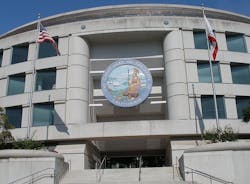California Stakeholders Now Have Until Dec. 15 to Submit Microgrid Tariff Proposals–But Still Must Meet Unacceptable Guidelines, Nonprofits Say
Non-utility stakeholders gained an extended deadline to file their own microgrid tariff proposals, but the process still involves guidelines that unfairly favor utilities, they say.
The new deadline is Dec. 15, an extension from the original timeframe ending Thursday.
In the California Public Utility Commission’s (CPUC) ongoing effort to establish a microgrid tariff for multi-property microgrids, the commission on Oct. 23 reversed course and invited non-utility parties to submit microgrid tariff proposals.
Despite the opening, the proposals must meet guidelines that effectively require the proposals to be based on utilities’ Community Microgrid Enablement Tariff (CMET), said Lorenzo Kristov, a consultant to the Climate Center who specializes in electric policy, structure and market design.
CMET is seen by The Climate Center and other stakeholders as a deterrent to commercializing microgrids.
When the California Legislature passed SB 1339 in 2018, the goal was to create a microgrid tariff that would help commercialize microgrids, allowing for third-party microgrid development and ensuring microgrids’ potential benefits would serve those who receive microgrid power, the grid and ratepayers.
But that’s not what the Microgrid Resources Coalition (MRC), Sunnova Energy and a group of nonprofits see happening before the CPUC in the proceeding addressing multi-property microgrids, which span more than one property and often require the use of utility distribution assets.
The nonprofits participating in the proceeding include The Climate Center, Green Power Institute, the Local Government Sustainable Energy Coalition and the Center for Biological Diversity.
Initially, non-utility stakeholders couldn’t submit proposed microgrid tariffs
In July, the nonprofits, Sunnova Energy and MRC argued that a July 18 CPUC memo eliminated, without explanation, important stakeholder participation processes that were included in the commission’s earlier ruling issued Dec. 17, 2021. The nonprofits asked for changes to the proceeding’s scope and schedule and requested a hearing, along with the ability to submit non-utility tariff proposals.
The Oct 23 CPUC order denied the nonprofits’ other requests but allowed for the non-utility tariff proposals. In its order, the CPUC said that comments, rather than testimony, are appropriate for this proceeding because it relates to policy.
Under the Oct. 23 order, the CPUC imposed requirements on parties filing non-utility tariff proposals that essentially force any tariff to be virtually the same as CMET, said Kristov. In addition, the proceeding now eliminates, with no explanation, a tariff proposal from the CPUC staff that had been scheduled for January, he said.
“Arbitrary and unrealistic deadline”
Allie Detrio, senior adviser, MRC, said the Nov. 9 deadline for submitting tariff proposals is “arbitrary and unrealistic for stakeholders to meet and provide the CPUC with legitimate robust tariff proposals that meet the rigorous CPUC standards.”
MRC, Sunnova and the nonprofits continue to argue that basing a microgrid tariff on CMET won’t lead to microgrid commercialization.
“Our concerns lie …with the ruling’s requirement that the IOUs’ (investor-owned utilities) pro forma tariff be limited to the CMET model. Multi-property microgrids could take many other configurations which would empower communities, especially low-income and environmental justice communities, and reduce cost,” said MRC in a response to the Oct. 23 order.
The CMET requires microgrid operators to build facilities to IOU specifications and operate them for the IOUs’ benefit, even though the IOUs pay nothing for either service, MRC said.
“The proposed tariffs are far too narrow in scope to achieve SB 1339’s goal of commercializing microgrids for the distribution customers of the IOUs,” said Sunnova Energy in its filing. CMET limits microgrids to providing resiliency during islanding for critical government facilities, Sunnova said.
How multi-property microgrids can be commercially viable
In an Oct. 27 filing, the Climate Center, Center for Biological Diversity, Green Power Institute and 350 Bay Area called for guiding principles from the CPUC for a multi-property microgrid tariff that would allow the microgrids to be commercially viable. To achieve this, microgrids would have to provide clean energy and resilience benefits to participating customers inside the microgrid and be allowed to participate as resources in the CAISO and retail markets, said the filing.
Under CMET, that’s not possible. Because the CMET limits microgrid operation to scenarios that involve utility grid outages, the tariff eliminates revenue opportunities that are critical to commercialization, said the nonprofits’ filing.
“Overall, commercializing microgrids means establishing provisions in the regulatory framework that enable a community or third party to deploy and operate a (multi-property microgrid) on a commercially viable basis, i.e., with the ability to recover all its costs from a stream of revenues for the services it provides, without relying on grants or some form of philanthropic funding or subsidy,” said the nonprofits’ filing.
Nonprofits seek CPUC staff tariff proposal not linked to CMET
The nonprofits asked the CPUC to authorize its Energy Division staff to develop an independent proposal that is not constrained to the CMET or other tariff concepts that restrict multi-property microgrids’ operation or commercial viability.
In an Oct. 31 filing, the nonprofit organizations also called for non-utility tariff proposals–along with the staff proposal–to be due Jan. 22, 2024. The group argued that stakeholder tariff filings due Nov. 9–one day before reply comments on the IOUs’ tariff filings are due–would make developing stakeholder tariff proposals challenging for parties who do not have extensive ratepayer-funded staff resources like those of the IOUs.
The nonprofit organizations also asked the CPUC to clarify the procedures that would enable multiproperty microgrids to participate as resources in the CAISO market and economically provide services to support the grid.
CAISO has participation rules for how many different types of resources can participate in its markets, said Kristov.
“To the best of my knowledge, the CAISO does not have specific rules for how a microgrid can participate as a resource in its markets,” he said.
If CMET becomes the governing tariff for multi-property microgrids, a microgrid that can participate in markets wouldn’t exist during blue sky–or non-islanded–conditions, he added.
Tariffs should allow continuous microgrid operation, groups say
“One of our main arguments is that the CPUC framework for (multi-property microgrids) should allow 24x365 operation, in which case an important revenue source for the microgrid would be participation in CAISO markets. So working out the participation rules is a key element of the future we want to create,” Kristov said.
In addition, if a multi-property microgrid could operate 24 hours a day, all year round, it could provide operational services to the distribution utility. This could include congestion relief on circuits with high-PV penetration. It could mean flattening load profiles on circuits with high penetrations of distributed energy resources instead of utilities’ expanding circuit capacity, he said. However, no provisions are available that would allow a microgrid operator to provide such services and be compensated for them, Kristov added.
Moving toward the grid of the future
While The Climate Center doesn’t expect these issues to be solved overnight, its hope is to work continuously toward creating a clean and resilient grid.
“We want to use these filings to continuously point toward the distributed power system of the future,” Kristov said.








